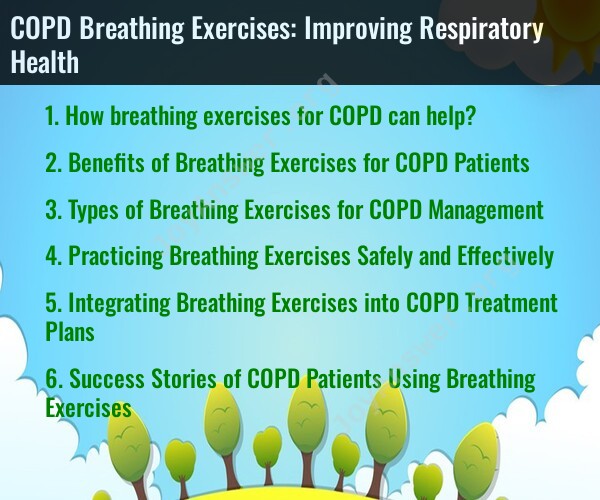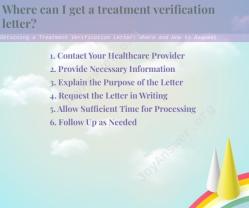How breathing exercises for COPD can help?
Breathing exercises can be beneficial for individuals with Chronic Obstructive Pulmonary Disease (COPD) to help improve respiratory health and manage symptoms. COPD is a progressive lung disease that includes conditions such as chronic bronchitis and emphysema. It can lead to shortness of breath, reduced lung function, and decreased exercise tolerance. Breathing exercises can help in several ways:
Improved Lung Function: Breathing exercises can strengthen the respiratory muscles and improve lung function. They can enhance the efficiency of oxygen exchange in the lungs.
Reduced Shortness of Breath: COPD often leads to shortness of breath, especially during physical activities. Breathing exercises can help reduce the perception of breathlessness and increase your ability to engage in daily activities.
Better Oxygenation: Some breathing exercises encourage deeper and more controlled breathing, which can increase oxygen intake and improve blood oxygen levels.
Enhanced Endurance: Regular practice of breathing exercises can increase your endurance, making it easier to engage in physical activities and reducing fatigue.
Mucus Clearance: In COPD, excess mucus production can lead to airway obstruction. Certain breathing techniques, like pursed-lip breathing and huff coughing, can help clear mucus from the airways, making it easier to breathe.
Stress Reduction: COPD can be stressful and anxiety-inducing. Breathing exercises, such as diaphragmatic breathing and meditation, can help reduce stress and anxiety, which can improve overall well-being.
Here are some common breathing exercises for COPD:
Pursed-Lip Breathing: Inhale through your nose for two counts and exhale through pursed lips for four counts. This technique can help slow down your breathing, reduce shortness of breath, and keep airways open.
Diaphragmatic Breathing: This technique focuses on deep breathing using the diaphragm rather than shallow chest breathing. Place one hand on your chest and the other on your abdomen. Inhale deeply through your nose, allowing your abdomen to rise while keeping your chest relatively still. Exhale slowly through pursed lips.
Segmental Breathing: Focus on one section of your lungs at a time. Inhale and expand one part of your chest while keeping the other parts still. Then exhale slowly and repeat with different sections.
Paced Breathing: Inhale for a specific count (e.g., four seconds), hold for a count, and exhale for the same count. You can gradually increase the count as your lung capacity improves.
Positive Expiratory Pressure (PEP) Therapy: Using a PEP device, you exhale through a resistor to create pressure in the airways, helping to clear mucus.
It's essential to learn these techniques under the guidance of a healthcare professional, such as a respiratory therapist or physical therapist, who can tailor exercises to your specific needs and monitor your progress. Additionally, maintaining a consistent exercise routine and following your healthcare provider's treatment plan are essential for effectively managing COPD.
Benefits of Breathing Exercises for COPD Patients
Breathing exercises can play a significant role in improving the quality of life for individuals with chronic obstructive pulmonary disease (COPD). These exercises can help strengthen the muscles involved in breathing, improve lung function, reduce shortness of breath, and enhance overall well-being.
Types of Breathing Exercises for COPD Management
Several breathing exercises are beneficial for COPD patients, including:
Diaphragmatic Breathing: This technique focuses on using the diaphragm, the primary muscle of respiration, to inhale deeply and efficiently.
Pursed-Lip Breathing: This method involves slowing down exhalation by pursing the lips, which helps keep the airways open longer and improve airflow.
Yoga Breathing: Pranayama, or yogic breathing techniques, can promote relaxation, reduce anxiety, and enhance overall respiratory function.
Incentive Spirometry: This exercise utilizes a handheld spirometer device to measure and strengthen respiratory muscles.
Practicing Breathing Exercises Safely and Effectively
To maximize the benefits of breathing exercises and minimize potential risks, follow these guidelines:
Seek Guidance: Consult with a healthcare professional or respiratory therapist to learn the proper techniques and ensure they are appropriate for your condition.
Start Gradually: Begin with short sessions and gradually increase the duration and frequency as your strength and endurance improve.
Practice Regularly: Aim to incorporate breathing exercises into your daily routine for optimal benefits.
Listen to Your Body: Pay attention to your body's signals and avoid overexertion or discomfort.
Integrating Breathing Exercises into COPD Treatment Plans
Breathing exercises should complement, not replace, prescribed COPD medications and lifestyle modifications. Work with your healthcare team to integrate breathing exercises into your overall treatment plan for comprehensive management.
Success Stories of COPD Patients Using Breathing Exercises
Numerous studies and anecdotal reports highlight the positive impact of breathing exercises on COPD patients. These exercises can help individuals regain control over their breathing, reduce reliance on medications, and improve their ability to participate in daily activities.
In conclusion, breathing exercises offer a valuable tool for COPD management, providing benefits such as improved lung function, reduced breathlessness, and enhanced quality of life. When practiced safely and regularly, these exercises can become an integral part of a comprehensive COPD treatment plan.












